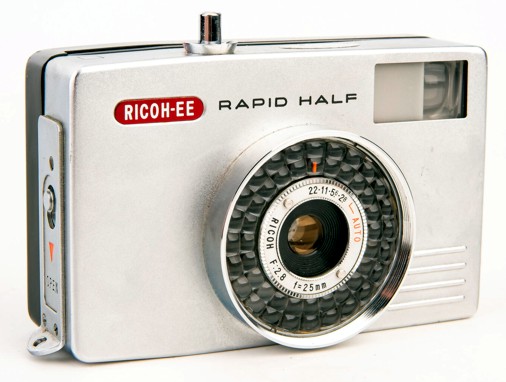

RICOH EE RAPID HALF
Another big change in the Ricoh EE Rapid is in the meter. The camera has the same fixed-focus 25mm (f2.8) lens as the other Ricoh Auto Half cameras (four elements in three groups). Depth of field is at least from 5 feet to infinity. But now there is a circular selenium cell around the lens -- instead of the square cell of the Auto Half. This allows the use of more standard round filters (46mm) instead of the square filters that Ricoh had to produce. Like other half-frame, auto-exposure cameras of the time, the EE offers two shutter speeds. The first, 1/125, is used when the camera is in auto-mode. Here, the meter automatically sets the aperture from f2.8 to 22 and displays the f-stop in the viewfinder. The film speed is set by the Rapid cassettes. There is a small tab on the side of the cassette that pushes a lever inside the camera. This is the same setup that the later 110 cassettes would use and assures correct film speed setting -- quickly and easily. A very nice touch in such a compact camera. A second shutter speed, 1/30, is used for flash-mode only. Take the camera off AUTO and 1/30 is automatically set. Then the f-stop can be selected manually on a dial around the lens. While there is no built-in flash shoe, a cold flash shoe was available as an accessory and screwed into the tripod socket. Ricoh also made special flash units that screwed into the tripod socket, as well. There is a tripod socket and PC contact on the side. The camera also has a cable release socket. A very small and stylish camera, indeed, but much harder to find than cameras in the Ricoh Auto Half line.
COPYRIGHT @ 1995, 1996, 1997, 1998, 1999, 2000, 2001, 2002, 2003, 2004, 2005 by Joe McGloin. All Rights Reserved.